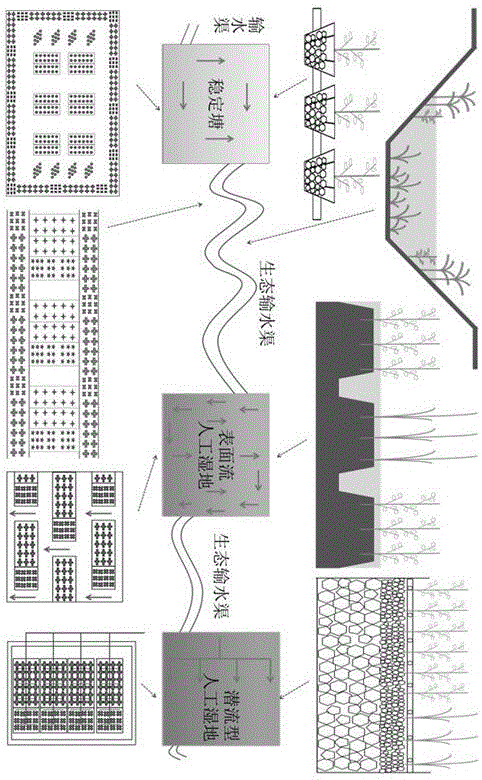Method for increasing total nitrogen removal rate for imbalanced carbon-nitrogen wastewater wetland by using aquatic plants
A technology of total nitrogen removal rate and aquatic plants is applied in the field of advanced treatment of tailwater structural wetlands in sewage treatment plants. The effect of reducing the insufficient purification capacity in winter, improving the total nitrogen removal rate, and alleviating the insufficient carbon source
- Summary
- Abstract
- Description
- Claims
- Application Information
AI Technical Summary
Problems solved by technology
Method used
Image
Examples
Embodiment Construction
[0015] A method of using aquatic plants to improve the total nitrogen removal rate of carbon-nitrogen unbalanced tail water, constructing a composite treatment system in series of stable pond-surface flow wetland-ecological aqueduct-horizontal subsurface flow wetland technology, through the absorption of aquatic plants, Microbial nitrification / denitrification, physical sedimentation and natural volatilization can gradually remove nitrate nitrogen and ammonia nitrogen from the water body. The core lies in the large number of aquatic plants planted in each process. The ratio of cold-season and warm-season aquatic plants is 2 : 1. Aquatic plants are not harvested throughout the year. Through the secretion of organic matter from the roots of aquatic plants and the decomposition of residues, the carbon and nitrogen imbalance in the water body can be gradually improved, and the nitrogen removal rate can be further improved. configuration to avoid secondary pollution caused by the dec...
PUM
| Property | Measurement | Unit |
|---|---|---|
| Particle size | aaaaa | aaaaa |
| Depth | aaaaa | aaaaa |
| Diameter | aaaaa | aaaaa |
Abstract
Description
Claims
Application Information
 Login to View More
Login to View More - R&D
- Intellectual Property
- Life Sciences
- Materials
- Tech Scout
- Unparalleled Data Quality
- Higher Quality Content
- 60% Fewer Hallucinations
Browse by: Latest US Patents, China's latest patents, Technical Efficacy Thesaurus, Application Domain, Technology Topic, Popular Technical Reports.
© 2025 PatSnap. All rights reserved.Legal|Privacy policy|Modern Slavery Act Transparency Statement|Sitemap|About US| Contact US: help@patsnap.com

